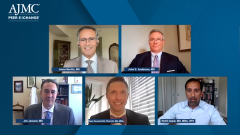
SGLT2 Inhibitor Impact on Hospitalization Reduction and HF Disease Progression
The impact of SGLT2 inhibitors in heart failure treatment is highlighted by the EMPEROR-Preserved and EMPEROR-Reduced trials.
Episodes in this series

Ryan Haumschild, PharmD, MS, MBA: Transitioning to Dr Anderson, we talked about SGLT2 [inhibitors]. The EMPEROR-Reduced and EMPEROR-Preserved trials both showed benefit of SGLT2 therapy on hospitalization and cardiovascular death. How do you see these results being applied in your practice? Dr [Jim] Januzzi talked about how sometimes we don’t want to see SGLT2s. What are some of the reasons you wouldn’t initiate this early on in some of the patient populations?
John E. Anderson, MD: That’s a great question. Remember, some of these trials aren’t that hot off the press. We’re talking about using SGLT2 inhibitors, which were “diabetes drugs” in prevention of CKD [chronic kidney disease], cardiovascular death, and hospitalization for heart failure in people who don’t have diabetes, and 40% to 50% of patients in those trials did have type 2 diabetes. It’s changing the mindset that this isn’t a glucose-lowering drug. This is a cardiometabolic set of drugs that have glucose-lowering properties as part of their effect.
There are some situations in which you wouldn’t want to initiate an SGLT2 early in therapy. Certainly in that rare case of a person who may have been hospitalized with euglycemic DKA [diabetic ketoacidosis], you’d want to stay away from it. Patients who have been on SGLT2 inhibitors and had recurrent genital mycotic infections [GMIs] that don’t go away may not be appropriate for SGLT inhibitors. In all the phase 3 clinical trials with SGLT2 inhibitors, 75% to 80% of people who got a GMI got just 1. They tend to not be recurrent, so it’s something we can get past.
I asked a nephrologist about 8 months ago, “Are you using SGLT2 inhibitors routinely?” He said, “No, those are diabetes drugs. We’ll let you guys start that.” That probably isn’t the right answer. We need to be using these. One thing I hear a lot from non-endocrinologists and non–internal medicine specialists is, “I’m not worried about their glucose lowering. I’m worried about what I do with their basal insulin.”
Many of these patients are going to have eGFRs [estimated glomerular filtration rates] of 45 mL/min or less. That’s the population in which we’re talking about a lot with heart failure. In those patients, you’re talking about A1C [glycated hemoglobin] reductions of 0.3% or 0.4% at best. Often, they don’t need to lower or alter the other glucose-lowering therapy. When we talk to specialists about initiating these, either let me initiate it, let the endocrinologist initiate it, or you initiate it and let them see me back. My nurses might be way better at handling genital mycotic infection calls than the cardiologist’s office. It’s a matter of breaking down barriers and trying to get these patients on evidence-based therapy whenever possible.
Transcript edited for clarity.
Newsletter
Stay ahead of policy, cost, and value—subscribe to AJMC for expert insights at the intersection of clinical care and health economics.





























































